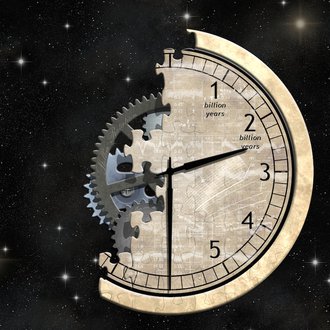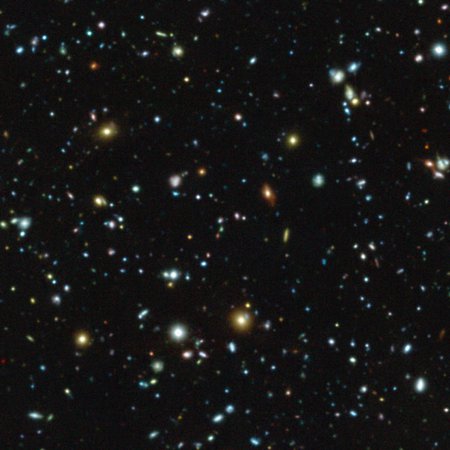Nature article: How stars reveal their ages

This artist's impression of a "cosmic clock" illustrates how astronomers have used stellar rotation to measure the ages of stars in a 2.5-billion-year-old star cluster. Their results, the latest success of gyrochronology, mark the first extension of such observations to stars with ages beyond 1 billion years, and toward the 4.6-billion-year age of the Sun. Being able to tell the ages of stars is the basis for understanding how astronomical phenomena involving stars and their companions unfold over time.
Credit: Michael BachofnerA recently published study in the scientific journal Nature presents a method by which the age of stars can be determined very precisely: "Gyrochronology", an analytical procedure for determining the ages of stars with knowledge of their masses and rotation periods. The word "Gyrochronology" is a neologism of the AIP scientist and co-author of the study, Sydney Barnes.
By observing and surveying 30 cool solar-type stars in the 2.5 Billion-year-old cluster NGC 6819 the international research team led by Søren Meibom of the Harvard-Smithsonian Center for Astrophysics, this method has now been shown to work over a wide age range, significantly improving the accuracy of stellar age determination.
"The relationship between mass, rotation rate and age of the observed stars is now defined well enough that by measuring the first two parameters, the third, the star's age, can be determined with only 10 percent uncertainty," said Barnes. The speed of rotation of a star decreases over time, and also depends on the mass of the star; heavy stars rotate faster than smaller, lighter ones, as a rule. While some aspects of this basic behavior have been known to astronomers for a while, this work has seized an opportunity to test and clarify the precision and accuracy of the method.
The newly released study firmly provides the intimate relationship between mass,rotation rate, and age of the cool star using coeval (same age) cluster stars so that the ages of even non-cluster (so-called ``field'') stars can be determined. The determination of the rotation rates was carried out by observing changes in brightness caused by star spots on the surface of the observed stars rotating into and out of view. At this age, a typical star changes its brightness by much less than 1 percent. Such precise observations were only possible using NASA's Kepler Space telescope.
This most accurate determination of the age of stars is important in understanding how various astronomical phenomena evolve over time. For example, knowledge of stellar ages can be helpful in targeting the search for life outside our solar system, because it has taken billions of years for the development of the complexity of life on Earth. Planets orbiting stars with ages similar to the sun are therefore seen as particularly promising objects of study.
Scientific contacts:
Dr. Sydney Barnes, sbarnes@aip.de, +49 157-3076 1230
Dr. Søren Meibom, smeibom@cfa.harvard.edu, +1 617496-4773
Media contact: Kerstin Mork, presse@aip.de, +49 331-7499 469

This artist's impression of a "cosmic clock" illustrates how astronomers have used stellar rotation to measure the ages of stars in a 2.5-billion-year-old star cluster. Their results, the latest success of gyrochronology, mark the first extension of such observations to stars with ages beyond 1 billion years, and toward the 4.6-billion-year age of the Sun. Being able to tell the ages of stars is the basis for understanding how astronomical phenomena involving stars and their companions unfold over time.
Credit: Michael BachofnerA recently published study in the scientific journal Nature presents a method by which the age of stars can be determined very precisely: "Gyrochronology", an analytical procedure for determining the ages of stars with knowledge of their masses and rotation periods. The word "Gyrochronology" is a neologism of the AIP scientist and co-author of the study, Sydney Barnes.
By observing and surveying 30 cool solar-type stars in the 2.5 Billion-year-old cluster NGC 6819 the international research team led by Søren Meibom of the Harvard-Smithsonian Center for Astrophysics, this method has now been shown to work over a wide age range, significantly improving the accuracy of stellar age determination.
"The relationship between mass, rotation rate and age of the observed stars is now defined well enough that by measuring the first two parameters, the third, the star's age, can be determined with only 10 percent uncertainty," said Barnes. The speed of rotation of a star decreases over time, and also depends on the mass of the star; heavy stars rotate faster than smaller, lighter ones, as a rule. While some aspects of this basic behavior have been known to astronomers for a while, this work has seized an opportunity to test and clarify the precision and accuracy of the method.
The newly released study firmly provides the intimate relationship between mass,rotation rate, and age of the cool star using coeval (same age) cluster stars so that the ages of even non-cluster (so-called ``field'') stars can be determined. The determination of the rotation rates was carried out by observing changes in brightness caused by star spots on the surface of the observed stars rotating into and out of view. At this age, a typical star changes its brightness by much less than 1 percent. Such precise observations were only possible using NASA's Kepler Space telescope.
This most accurate determination of the age of stars is important in understanding how various astronomical phenomena evolve over time. For example, knowledge of stellar ages can be helpful in targeting the search for life outside our solar system, because it has taken billions of years for the development of the complexity of life on Earth. Planets orbiting stars with ages similar to the sun are therefore seen as particularly promising objects of study.
Scientific contacts:
Dr. Sydney Barnes, sbarnes@aip.de, +49 157-3076 1230
Dr. Søren Meibom, smeibom@cfa.harvard.edu, +1 617496-4773
Media contact: Kerstin Mork, presse@aip.de, +49 331-7499 469
Images
This artist's impression of a "cosmic clock" illustrates how astronomers have used stellar rotation to measure the ages of stars in a 2.5-billion-year-old star cluster. Their results, the latest success of gyrochronology, mark the first extension of such observations to stars with ages beyond 1 billion years, and toward the 4.6-billion-year age of the Sun. Being able to tell the ages of stars is the basis for understanding how astronomical phenomena involving stars and their companions unfold over time.



